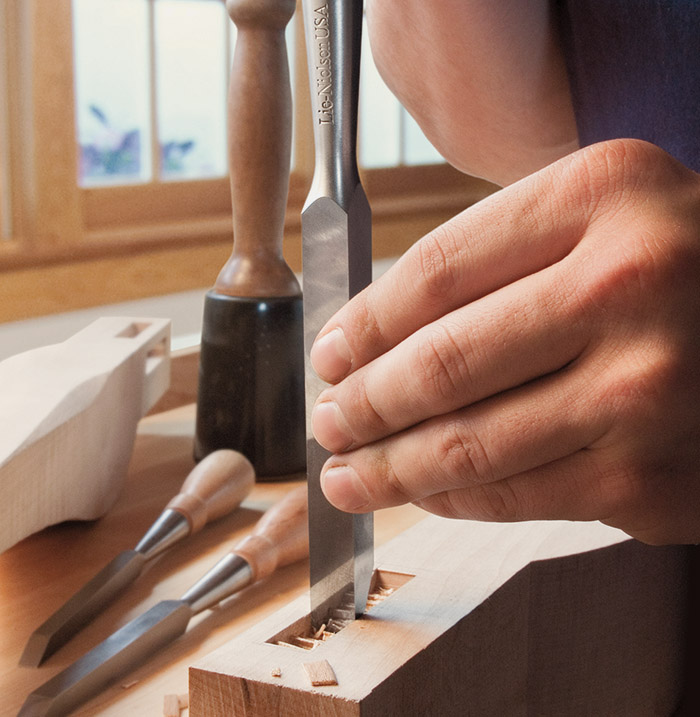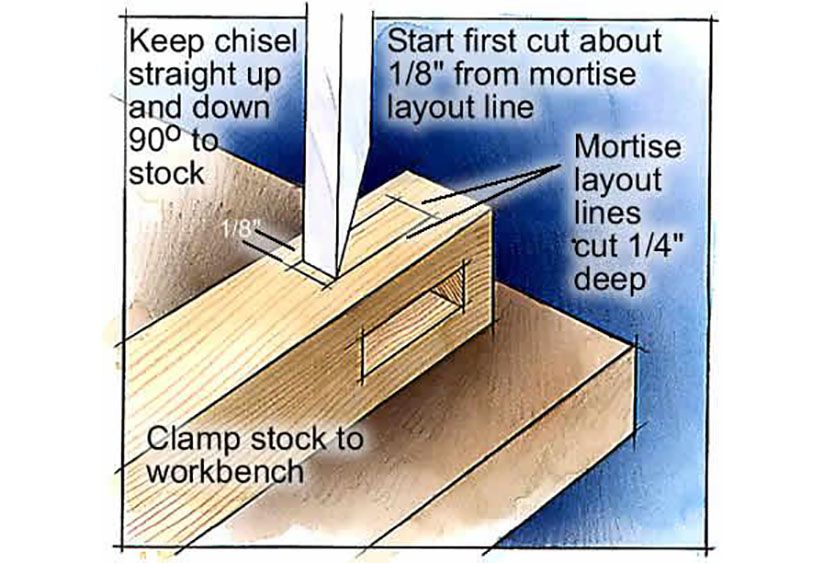If you’ve ever wondered, “What are the uses of a mortise chisel?” then you’re in the right place! Mortise chisels are versatile tools that come in handy for various woodworking projects. Whether you’re a beginner or an experienced woodworker, understanding the uses of this tool can take your craftsmanship to the next level.
So, what exactly is a mortise chisel? Well, it’s a specially designed chisel with a rectangular, sturdy blade and a comfortable handle. The unique shape of the blade allows it to create precise, square-edged cuts in wood, making it perfect for creating mortise and tenon joints.
With these joints, you can easily join pieces of wood together securely and flawlessly. But that’s not all! Mortise chisels can also be used for other woodworking tasks, such as removing excess material, creating decorative features, and even shaping wood. They’re a must-have in any woodworker’s toolkit!
So, whether you’re a budding woodworker or just curious about the amazing uses of a mortise chisel, keep reading to discover the endless possibilities this tool offers. Prepare to unlock your woodworking potential and dive into the fascinating world of mortise chisels!

The Uses of a Mortise Chisel: Unlocking its Versatility and Precision
Welcome to our guide on the uses of a mortise chisel! Mortise chisels are essential tools for woodworking, providing the precision and control necessary for creating clean and accurate mortise joints. In this article, we will explore the various applications of a mortise chisel, from creating mortise and tenon joints to shaping and carving wood. Whether you are a novice woodworker or an experienced craftsman, understanding the versatility and benefits of a mortise chisel will undoubtedly enhance your woodworking projects.
Creating Strong and Reliable Mortise and Tenon Joints
One of the primary uses of a mortise chisel is to create mortise and tenon joints. These types of joints are commonly used in woodworking to join two pieces of wood securely and permanently. The mortise chisel is used to carve out a square or rectangular hole (the mortise) in one piece of wood, while the tenon, a corresponding protrusion, is formed on the other piece of wood. The mortise chisel allows for precise and controlled removal of wood to create a perfect fit, ensuring a strong and reliable joint.
When using a mortise chisel for creating mortise and tenon joints, it is crucial to mark the desired dimensions of the mortise accurately. Use a marking gauge or measuring tools to outline the boundaries of the mortise. Then, using a mallet, apply controlled and even force to the mortise chisel to remove the wood within the marked boundaries. Take your time and make frequent checks for depth and accuracy. The result will be a well-crafted joint that will provide strength and stability to your woodworking projects.
Shaping and Carving Wood with Precision
Beyond creating mortise and tenon joints, a mortise chisel is a versatile tool for shaping and carving wood. The sharp, beveled edge of the chisel allows for controlled and accurate cutting of wood, making it perfect for shaping and carving intricate designs. Whether you are creating a decorative edge on a tabletop or sculpting intricate details on a piece of furniture, a mortise chisel is an invaluable tool for achieving precise and clean results.
When using a mortise chisel for shaping and carving wood, it is important to start with a well-sharpened chisel. Dull blades can cause rough and uneven cuts, compromising the quality of your work. To ensure smooth and controlled cutting, apply controlled force with a mallet or hammer, guiding the chisel along the desired lines or contours. Take breaks to inspect your progress and make any necessary adjustments. With practice and patience, you will be able to harness the power and precision of a mortise chisel to create stunning woodworking masterpieces.
Using a Mortise Chisel for Precision Joinery
Mortise chisels are indispensable for precision joinery, allowing woodworkers to create strong and seamless connections between wood components. Whether you are building furniture, cabinets, or doors, a mortise chisel will facilitate the creation of hidden joints that provide long-lasting strength and stability.
To begin using a mortise chisel for precision joinery, first, mark the location and dimensions of the mortise on the wood. Then, position the chisel at the marked starting point, aligning it perpendicular to the wood grain. Use a mallet to apply controlled force, gradually removing the wood within the marked boundaries. Remember to check the depth regularly, making adjustments as needed. Once the mortise is complete, the corresponding tenon can be created using a saw or other suitable tools. The precision and control offered by a mortise chisel make it an essential tool for achieving seamless joinery in woodworking projects.
When working with a mortise chisel, it is crucial to practice patience and precision. Take your time in creating accurate and clean cuts, as rushing can lead to mistakes or damage to the wood. Additionally, always wear appropriate safety gear, including eye protection and gloves, to ensure a safe and enjoyable woodworking experience.
The Benefits of Using a Mortise Chisel
There are several benefits to using a mortise chisel in woodworking projects. Firstly, the chisel’s sharp and beveled edge allows for precise and controlled cutting, resulting in clean and accurate work. This precision is vital when creating tight-fitting joints, ensuring that the wood components fit together seamlessly. Secondly, mortise chisels are highly versatile and can be used for various woodworking tasks beyond creating mortise and tenon joints. From shaping wood to carving intricate designs, a mortise chisel provides the versatility necessary for a wide range of projects. Finally, the use of a mortise chisel enhances the overall strength and durability of woodworking joints. By creating secure and snug mortise and tenon joints, woodworkers can confidently construct furniture and other wooden structures that will stand the test of time.
In conclusion, a mortise chisel is a valuable tool for any woodworker, offering the precision and control necessary for creating strong and seamless joints. From mortise and tenon joinery to shaping and carving wood, the uses of a mortise chisel are varied and indispensable. By incorporating this versatile tool into your woodworking projects, you can elevate the quality and craftsmanship of your creations. Remember to practice patience and precision when working with a mortise chisel, and always prioritize safety by wearing appropriate gear. Unlock the full potential of your woodworking projects with the incredible capabilities of a mortise chisel!
Key Takeaways: What are the uses of a mortise chisel?
- A mortise chisel is a specialized tool used in woodworking to create square or rectangular holes.
- It is commonly used in joinery and cabinet making to create mortise and tenon joints.
- With a sharp and durable blade, a mortise chisel can accurately remove waste material from the wood, creating a precise and clean hole.
- It can be used for various tasks such as making door hinges, furniture joints, and cutting out intricate designs in wood.
- Proper technique and caution should be used when using a mortise chisel to ensure safety and avoid damage to the workpiece.
Frequently Asked Questions
Welcome to our frequently asked questions page about the uses of a mortise chisel. If you’re curious about the different ways this tool can be used, you’ve come to the right place. Read on to discover more!
Q: Can a mortise chisel be used for carving wood?
A: Yes, a mortise chisel can be used for carving wood, although it is primarily designed for making mortises. With its sharp and sturdy blade, it can effectively remove large chunks of wood, making it suitable for certain types of wood carving. However, it’s important to note that there are other chisels specifically designed for carving that may be more suitable for detailed or intricate work.
If you’re primarily interested in wood carving, it may be worth exploring different types of chisels that are better suited for that particular craft. However, if you already have a mortise chisel at hand, it can certainly be used for carving wood in certain applications.
Q: What are some other applications of a mortise chisel besides making mortises?
A: Besides making mortises, a mortise chisel has several other applications. One common use is for chopping or paring away excess wood or creating clean and precise joints. It can be used to shape and form wood, especially when working with larger pieces, thanks to its sturdy construction.
Additionally, a mortise chisel can be useful for general woodworking tasks such as cutting notches, removing wood in tight corners, or creating detailed recesses. Its sharp and durable edge makes it a versatile tool for various woodworking projects.
Q: How does a mortise chisel differ from other types of chisels?
A: The main difference between a mortise chisel and other types of chisels lies in its design and purpose. A mortise chisel typically has a thicker and stronger blade compared to other chisels. Its stronger construction allows it to withstand the force needed for making mortises – rectangular holes in wood used to insert tenons.
In contrast, other types of chisels, such as bench chisels or carving chisels, have thinner and more delicate blades suitable for fine detailing and precise cutting. These chisels are not designed to withstand the same amount of force as a mortise chisel and are better suited for lighter woodworking tasks.
Q: What are the benefits of using a mortise chisel instead of other tools?
A: One of the main benefits of using a mortise chisel is its strength and durability. Its thicker blade allows it to handle heavy-duty woodworking tasks, such as making mortises or removing large amounts of wood, with ease. This makes it a reliable tool for professionals and hobbyists alike.
Another benefit of using a mortise chisel is its versatility. While its primary function is making mortises, it can also be used for other woodworking applications, as mentioned earlier. This versatility saves time and effort by eliminating the need for multiple specialized tools.
Q: Can a mortise chisel be used on materials other than wood?
A: While a mortise chisel is primarily designed for woodworking, it can potentially be used on other materials such as softer metals or plastics. However, it’s important to note that using a mortise chisel on non-wood materials may dull the blade more quickly and could damage the tool.
If you need to work with non-wood materials, it’s generally recommended to use tools specifically designed for those materials. This will ensure both the safety of the user and the longevity of the tool.

Summary
A mortise chisel is a tool used to carve out square or rectangular holes in wood. It has a long, sturdy blade and a sharp cutting edge.
You can use a mortise chisel to create mortise and tenon joints, which are strong and durable. These joints are commonly found in furniture and other wooden structures.
Additionally, a mortise chisel can be used for shaping wood and removing waste material. It is an essential tool for carpenters and woodworkers who work with wood on a regular basis.
In conclusion, a mortise chisel is a versatile tool that is used for carving out holes and creating strong joints in wood. It is an indispensable tool for any woodworking project.
